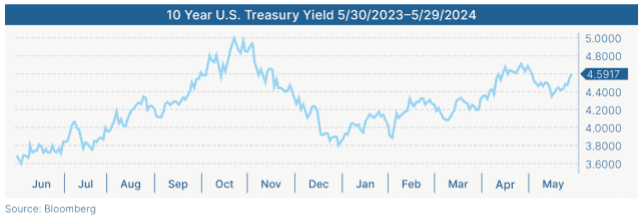Presented by Bisdorf Palmer, LLC
We started the year with most economists and investors expecting markedly slower growth in 2024 due to high interest rates, slowing consumer spending, and a weakening job market. Economic data has largely defied these expectations through the first half of the year as a surprisingly strong job market helped support continued consumer spending and economic growth.
Although this stronger-than-expected start to the year was largely welcome, it contributed to higher-than-expected inflation. That, in turn, caused interest rates to rise and put pressure on the Federal Reserve (Fed). These mixed economic results led to mixed investor results, as stocks were up while bonds were down.
Investors are now left wondering what will happen in the second half of the year. Will growth continue to be hotter than expected and fuel more concerns about inflation or will we see a slowdown due to restrictive monetary policy and high interest rates? To answer that, we’ll need to look to the data for signs of what’s to come.
EXPECTATIONS

Slowing—But Solid—Economic Growth
Despite concerns, the economy remained quite strong at the start of the year. There have been signs, however, that the rapid growth may start decelerating in the months ahead. The April jobs report showed hiring slowed significantly, a positive sign for investors and economists concerned about a potentially overheating economy. Despite strong hiring in May, other indicators, such as increased unemployment and declining consumer and business confidence in the second quarter, point to a moderating economy, potentially leading to more sustainable long-term growth.

Inflation is still a major risk for the economy and markets, with prices for everyday goods and services rising rapidly. This has prompted the Fed to keep interest rates high in an effort to cool the economy and get inflation under control, which led to short-lived market disruptions in the first half. Signs now indicate that economic growth may slow in the months ahead, which should help reduce upward pressure on prices in the second half of the year.
Market Fundamentals Improving
While external factors such as interest rates and economic updates can have a short-term impact on markets, fundamentals are what really drive market performance over the long run. Encouragingly, the start of 2024 saw continued fundamental improvements for stocks; companies reported better-than-expected earnings growth in the first quarter. In fact, the average earnings growth rate for the S&P 500 was 7.7 percent in the first quarter, more than double analyst estimates at the start of earnings seasoni.
Looking ahead, investors expect to see continued strong earnings growth, with estimates calling for high single-digit growth in both the second and third quarters of 2024, followed by low double-digit growth in the fourth quarter. If these estimates prove accurate, it could translate into a strong second half of the year for equity markets, building on the solid start.
Interest Rates and Fixed Income
The beginning of 2024 was more challenging for bond investors. Interest rates rose in the first half, with the 10-year Treasury yield climbing from roughly 3.9 percent in January to approximately 4.6 percent by the end of May. This rising interest rate environment weighed on bond prices, keeping returns muted across most fixed income sectors.

Entering 2024, markets anticipated that the Fed would cut interest rates five to six times over the course of the year. Those expectations have been significantly scaled back due to strong economic growth and stubbornly high inflation in the first six months, which, in turn, caused interest rates to rise.
After a challenging first half of the year for bond investors, the rising interest rate environment has helped set the stage for a better second half. Fixed income valuations currently look favorable across several sectors, with various investment-grade bond sector yields at or near their highest levels in a decade.
In addition, though valuations are attractive, the headwinds bond investors faced early in the year are expected to soften or potentially reverse course by year-end. Inflation is set to slow as we enter the second half of the year and the Fed begins cutting rates later this year. Although markets no longer expect to see five or six rate cuts by December, one or two cuts remain possible and could spark a rally for bonds to close out the year.
Real Risks Remain
Risks to our outlook should be considered, with inflation remaining the primary domestic threat as we head into the second half of 2024. Although recent economic data releases give reason to believe that we’ll see slowing inflation ahead, a potential reacceleration of rising prices would likely rattle bond and stock markets.
In addition, we face considerable political instability due to U.S. federal elections in November. We’re likely to see this uncertainty ramp up as the political convention season kicks off this summer and we get closer to election day in the fall.
International risks remain as well. The ongoing war in Ukraine, continued conflicts in the Middle East, and China’s economic slowdown all have potential to cause further regional and global uncertainty that could spill over to the broader world economy in the second half of the year.
And, of course, there are always unforeseen risks that could negatively impact markets and affect the economic outlook in the months ahead.
POSITIVE OUTLOOK
Here’s the good news: Despite the risks, our outlook remains broadly positive. More moderate economic growth should help bring the economy back into balance in the second half of the year, with slowing job and spending growth set to help tamp down inflationary pressure. Stock market fundamentals are improving, and bond valuations are compelling. Risks certainly remain, but that is always true. And we’ve seen markets weather short-term risks well through the start of the year, so we remain optimistic as we kick off the year’s second half.
Certain sections of this commentary contain forward-looking statements that are based on our reasonable expectations, estimates, projections, and assumptions. Forward-looking statements are not guarantees of future performance and involve certain risks and uncertainties, which are difficult to predict. Investments are subject to risk, including the loss of principal. Past performance is no guarantee of future results. This material is intended for informational/educational purposes only and should not be construed as investment advice, a solicitation, or a recommendation to buy or sell any security or investment product.
Authored by Sam Millette, director, fixed income, at Commonwealth Financial Network®.
© 2024 Commonwealth Financial Network®.
i Source: Bloomberg Intelligence.




